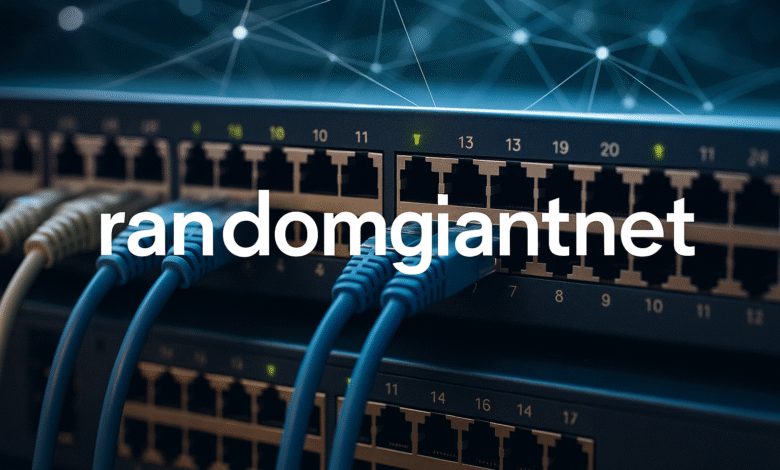Understanding RandomGiantNet: A Conceptual Exploration

The digital world is filled with ever-evolving terminologies, technological frameworks, and complex infrastructures. Navigating this intricate space often requires decoding unfamiliar terms that surface in various tech contexts. One such term that might raise curiosity is randomgiantnet. While it isn’t an officially recognized standard in the field of networking or internet protocols, this term has potential significance based on its structure and usage. This article aims to dissect the meaning, implications, and contextual applications of randomgiantnet, offering a comprehensive overview.
What Does RandomGiantNet Refer To?
To start, randomgiantnet is not part of mainstream internet jargon or standardized networking terminology. However, the phrase can be broken down into three distinct components that help frame its conceptual meaning:
-
Random: Denotes unpredictability, non-deterministic behavior, or absence of a defined pattern.
-
Giant: Suggests a significant size or scale—possibly vast numbers of connections, nodes, or bandwidth capacity.
-
Net: Short for “network,” referring to a system of interconnected devices, computers, or services.
Putting these ideas together, randomgiantnet may be used to describe a large-scale, loosely structured network that exhibits randomness in its architecture, data flow, or operational behavior.
Possible Interpretations and Uses of RandomGiantNet
Despite its unofficial status, the term randomgiantnet can be applied descriptively in various technological scenarios. Below are some plausible interpretations:
1. Network Simulation and Modeling
In academic and research environments, modeling complex networks is essential to analyze behavior, efficiency, and failure tolerance. A randomgiantnet could represent a simulated network where connections, routes, or nodes are generated randomly. Researchers might use such models to study data traffic flow, protocol efficiency, or vulnerabilities in decentralized environments.
For instance, simulating a decentralized social media platform where user connections are organically formed could fall under the idea of a randomgiantnet.
2. Distributed Cloud Systems
Modern cloud services operate using distributed computing infrastructures that span across numerous physical and virtual servers. In some contexts, especially where services and tasks are dynamically assigned based on system load or demand, the underlying network may appear random in nature.
Although actual operations are algorithmically managed, the unpredictability in resource distribution and scaling may lead observers to view the architecture as a randomgiantnet.
3. Peer-to-Peer (P2P) Networks
P2P systems, such as those used for file sharing or blockchain technologies, are inherently decentralized and highly dynamic. Connections form and dissolve frequently, leading to a topology that lacks a fixed structure.
A vast P2P platform involving thousands—or even millions—of users could be described as a randomgiantnet due to the unpredictable way nodes interact and the scale at which they operate.
4. Malicious Botnets
The darker side of networking includes malicious randomgiantnet examples, such as botnets. These are massive collections of compromised computers used to carry out coordinated cyberattacks. Their internal command structures can appear random to evade detection.
A botnet may select nodes unpredictably for specific tasks, making it difficult for security systems to detect patterns. This form of randomgiantnet represents significant security threats due to its scale and erratic behavior.
5. Internet-Wide Data Patterns
At the macro level, the global internet can also resemble a randomgiantnet. With billions of users accessing data, streaming content, and initiating unpredictable connections across different time zones, the overall traffic flow appears chaotic.
While governed by standardized protocols, the emergent properties of such a massive, constantly evolving system embody the randomness and giant-scale nature inherent to the term randomgiantnet.
Key Implications of a RandomGiantNet-Like Structure
Understanding what a randomgiantnet entails brings several important considerations to light:
-
Fault Tolerance: Random networks often resist localized failures effectively. If one connection drops, multiple alternatives may still exist, making the network resilient.
-
Ease of Scaling: The less rigid the structure, the more easily new nodes and connections can be added without extensive reconfiguration.
-
Security Risks: The same randomness that enables resilience can complicate monitoring. Detecting anomalies, threats, or breaches in such environments can be challenging.
-
Optimization Complexity: Performance tuning in a randomgiantnet may require advanced routing techniques and real-time traffic analysis, as traditional methods may not apply.
-
Emergent Behaviors: Large, loosely defined networks often show behaviors that aren’t predictable from individual node actions. Understanding these patterns is crucial to network management.
Final Thoughts
Although randomgiantnet isn’t an official technical term, it serves as a useful conceptual framework for discussing large, complex, and unpredictable network environments. Whether applied to a research model, a P2P platform, or even a rogue botnet, the term captures the essence of scale combined with structural randomness.
What makes randomgiantnet particularly intriguing is how it bridges theoretical understanding and practical application. It challenges us to think about how we manage, secure, and optimize networks that defy traditional architecture.
In today’s digital age, where scalability, decentralization, and unpredictability often define success, understanding the nature of a randomgiantnet could offer valuable insight into the future of networking.
FAQs About RandomGiantNet
Q1: Is randomgiantnet a real network protocol or standard?
No, randomgiantnet is not a formally recognized protocol. It is a conceptual term that combines ideas of randomness and large-scale networking.
Q2: Where might the concept of randomgiantnet be used?
It can apply in academic research, distributed cloud infrastructures, peer-to-peer systems, botnet analysis, or discussions about internet traffic modeling.
Q3: Can a randomgiantnet be secure?
Security in a randomgiantnet is complex. While its decentralized nature offers resilience, detecting and responding to threats is often more difficult due to lack of structure.
Q4: Why is randomness important in large networks?
Randomness introduces diversity and unpredictability, which can enhance fault tolerance and simulate real-world network behavior for research and optimization.
Q5: What are the challenges in managing a randomgiantnet?
Major challenges include performance optimization, security management, monitoring emergent behavior, and ensuring consistent quality of service across the network.
Read also:High-Performance Modular Systems: Exploring the RE-EF-5K4451X



